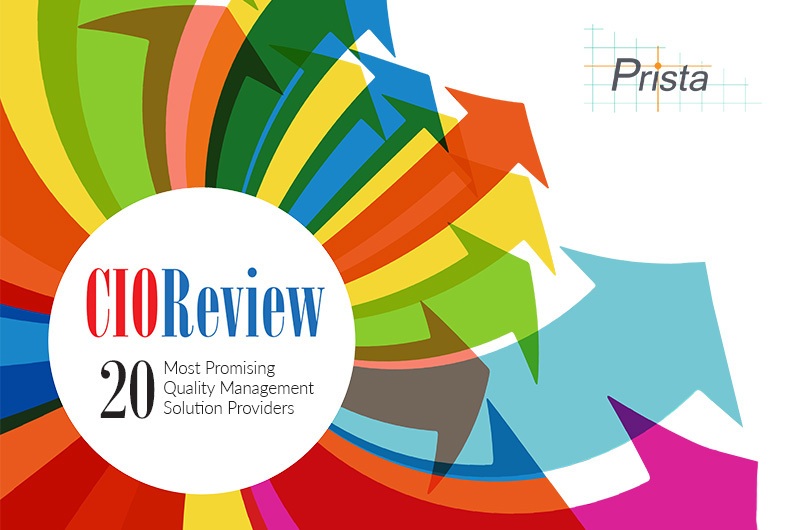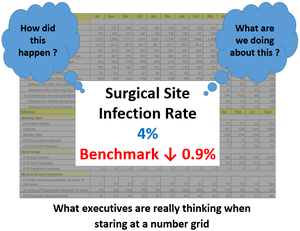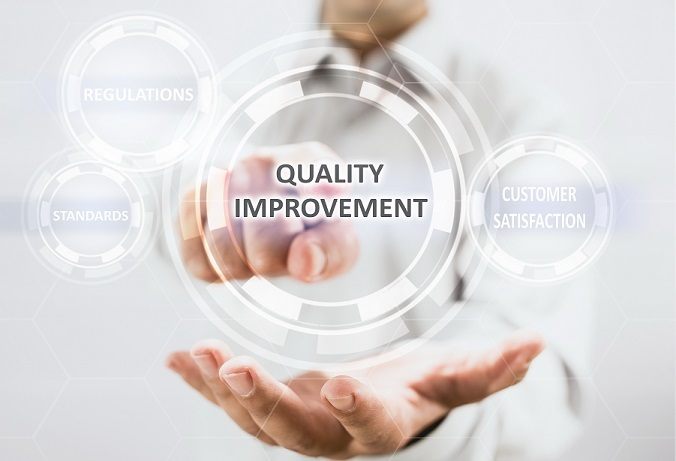All posts by Faris Islam

Bouncing Back from a Hospital Safety Penalty
In December of last year, the federal government penalized 751 hospitals for having high numbers of patient injuries, retroactively reducing their Medicare payments by 1% for each patient’s stay, as well as reducing the amount of money the hospitals receive to teach medical residents and care for low-income individuals. These reductions will continue until the end of the government’s fiscal year in September of 2018. The harsh reality of reductions for those listed hospitals, and the potential financial and operational impacts on other hospitals in the future, serve as a call for action among hospital leaders.
The penalties are controversial. Many in the industry feel they unfairly target academic hospitals, which treat patients with more complex conditions and increased risk of developing HAIs (Hospital Acquired Infections), as well as hospitals that treat more low-income patients. The true intent of the penalties is to incentivize hospitals to continually focus on improving patient safety and quality. It is important to note, however, that of the 751 hospitals penalized for FY 2018, 425 were also penalized the previous year. Clearly, something needs to change.
Looking Towards the Future
While the penalties are not without fault, the program is expected to continue and hospitals will remain under scrutiny. So how do we work to improve overall patient safety and ensure penalized hospitals don’t become repeat offenders in 2019? In the midst of turmoil and uncertainty within the healthcare industry, increased CMS measures, and with a reduction in funding at stake, it’s never been more important to ensure your healthcare facility is utilizing a quality/risk management and performance improvement process that is both effective and efficient in mitigating, or even reversing, rising administrative overhead costs.
ActionCue CI provides capabilities for event reporting, quality management and performance improvement tracking in one easy-to-use online platform. It’s simple, collaborative and insightful, giving healthcare professionals access to real-time data that helps to streamline safety event reporting, while integrating it with quality and making performance improvement efforts much clearer and easier. This means your staff can not only quickly and efficiently document safety events, but also monitor the actions being taken to improve performance related to the area of concern. In 2018, Prista has worked with multiple healthcare organizations to document quality and safety improvements that have resulted in cost savings from $600,000 over the course of 10 months, to more than $1 million in prevented negative outcomes.
The system compiles and securely stores details on every adverse event, along with investigation procedures and findings, through a role-based workflow. With ActionCue’s clear and insightful visualizations, executives can easily view reporting and benchmarking, and tailor reports in minutes with just a few clicks. Our goal is not only to improve quality and performance management, but to ensure staff find day-to-day processes more efficient and enjoyable.
We value every effort hospitals are making to improve patient safety and overall quality of care. A safety penalty and subsequent reduction in funding is an unfortunate circumstance to say the least, but we’re here to help penalized hospitals bounce back and take the right step towards quality and performance improvement. If you’re interested in learning more about ActionCue, read what our clients have to say about the tool, check out our video library, or contact us today to discuss how we can work together to make a positive impact on patient care.

Prista Named One of 2017’s Most Promising Quality Management Solution Providers
CIOReview recently recognized Prista Corporation as one of 2017’s “20 Most Promising Quality Management Solution Providers,” and we’re proud to have been recognized as a company that has demonstrated an exceptional ability to innovate and customize a solution that meets our clients’ quality management needs.
The December issue of CIOReview is centered around the idea that quality management is no longer a nice-to-have addition, but an aspect that is imperative for businesses to survive in the current competitive landscape. While this is certainly true, we believe when it comes to healthcare IT, a successful tool must enable quality management, safety event reporting and performance improvement teams to work collaboratively and efficiently, eliminating inconsistent, disorganized information, and facilitating effective improvement powered by real-time insights. Our mission to provide a tool that’s simple, collaborative and insightful was the driving force behind the development of the ActionCue CI application.
According to the magazine, ActionCue CI has changed the way hospitals manage risk, quality, and performance improvement by making information easy to access and understand. Our quality management clients appreciate ActionCue’s ability to provide insights, rather than numbers, through detailed reports that highlight the “big picture.” They can view reports and track data and trends in real-time, without ever touching a spreadsheet. With the ability to quickly investigate causes and manage corrective actions, our clients are able to take real steps toward improving patient care.
We’re delighted to have been recognized for our efforts in providing a solution that our clients truly value. If you’d like to learn more about ActionCue CI and why our innovation and commitment to increasing patient care quality is fostering a new “Culture of Quality” within the healthcare industry, check out some of our informational videos or read what our clients have to say about the tool.

Increasing Efficiency in 2018
It’s the beginning of a new year, and in 2018 the healthcare industry would greatly benefit from better utilization of resources. U.S. health care spending grew 4.3 percent in 2016, reaching $3.3 trillion, while an estimated $1 trillion is wasted each year on inefficiencies, redundancies and abuse. With an aging population, and chronic illnesses and obesity on the rise, emergency department staff will continue to be flooded with patients, while hospitals work to comply with new CMS mandates and rulings, and improve quality of patient care.
Hospitals are constantly working to increase productivity and reduce expenditures, while statistics continue to remind us that time is money. In 2017, EY conducted an advisory study of the healthcare industry, and after analyzing the data, suggested a holistic approach to reducing inefficiencies and improving quality of care. Of the five points presented, we’ll focus on the three areas where our ActionCue CI platform can make a significant impact for healthcare organizations in 2018: transforming the culture, advancing with analytic insights, and increasing productivity
Transforming the Culture
In 2017, we presented a four-part series on innovation and the role of leadership in creating action that improves patient safety and quality. A recurring theme in the series, and a concept we work to continuously promote, is creating a “culture of quality.” Improving culture is the first step towards improving patient safety and reducing inefficiency, and it must begin at the top. Organizational leadership must be deeply involved and aware of the challenges clinical staff face daily. Executive engagement is crucial to improving overall culture, but it’s no secret that executives face substantial time constraints. According to Becker’s Hospital Review, the average CEO spends about 2.5 hours per day in meetings, and 21.2% of a CEO’s solitary workday is devoted to reading and analyzing reports.
ActionCue CI allows staff to create comprehensive, easy-to-read reports in minutes, not days, providing real-time access to insights and performance measures while reducing time spent in meetings or analyzing confusing data sets. This creates more time for leadership to engage with clinical staff and take a more involved approach to culture. Because 51% of EY respondents believe employee satisfaction in healthcare drives patient satisfaction, not only will this boost morale, it will positively impact patient care.
Advancing with Analytic Insights
Access to reliable, accurate and insightful data is imperative as hospitals work to improve performance and quality. There’s more focus on patient outcomes than ever before, and as CMS continues to impose regulations and mandates, the spotlight is on hospitals to perform or risk losing funding. Executives need immediate access to meaningful metrics on safety events, corrective actions, performance indicators, quality management, risk management and more.
With event reporting, quality management and performance improvement tracking in one easy-to-use online platform, ActionCue CI is your Fast Path to Insight™. Its robust, real-time reporting features give executives the data they need to be proactive, rather than reactive, and drive better clinical outcomes.
Increasing Productivity
Organizations’ leaders have historically accepted that quality and safety efforts require a large amount of time and effort, and lengthy processes. However, we believe applications should focus on collaboration and workflows that not only match the natural tasks and processes of users, but also shape the users’ behavior by encouraging methodologies that produce targeted results, and increase efficiency and accountability.
ActionCue’s design goes beyond ease-of-use to advance the way in which healthcare organizations engage with information in an application. The platform proves to be an enjoyable working team member, increasing productivity and facilitating education and improvement towards goals. Executives hoping to cut costs in 2018 should place significant focus on improving productivity and efficiency. With low operation costs, no hardware or installation requirements, and month-to-month subscriptions, the impact of ActionCue CI on cost reductions is two-fold.
As the healthcare industry continues to place more emphasis on quality and performance improvement, and improved clinical outcomes, 2018 promises to be a year during which increased efficiency and better utilization of resources is a major focus, and rightly so. If you’d like to learn more about how ActionCue CI can help you reach your quality and performance improvement goals more efficiently, contact us today and start 2018 off on the right foot.

PDCA vs. OODA: Facilitating a More Effective Improvement Methodology
As we work to continually evolve Prista’s ActionCue Clinical Intelligence (CI) application as the leading performance improvement workbench in the healthcare market, we often dig into the essence and science of improvement itself. The ActionCue application not only embodies well-designed and powerful information processing, but also demonstrates an awareness of the principles and psychological aspects of improvement methodologies.
Since the application is designed around these fundamentals and not overtly focused on the mechanics of any particular methodology, ActionCue’s design can support a variety of improvement mentalities. One approach to improvement frequently used in circles outside healthcare is the “Observe, Orient, Decide, Act” (OODA) cycle illustrated above. Ultimately, OODA is comparable in process and effectiveness to the “Plan, Do, Check, Act” (PDCA) cycle, but is nuanced in ways that may be applicable and valuable for healthcare .
As widely understood and utilized as the PDCA cycle is, many people subliminally think of the cycle and its steps as always in process across a variety of projects or topics, which can help support continuous improvement. While such cycles are intended to be continuous, the application of PDCA often begins with a plan developed by trained experts, to study certain functions or performance measures, or experiment with a technique, practice or protocol. Unfortunately, time and resource constraints in healthcare quality and safety efforts frequently dictate that as one improvement plan is undertaken, another gets retired.
OODA begins when someone—in some cases an improvement specialist, but often an executive—observes something that needs to be improved. This makes the process seem more immediately reactive than PDCA, which explains the popularity of OODA in the military and construction industry, where unexpected challenges arise requiring critical and immediate attention. Although it’s helpful for those initiating any process to denote a starting point,

Consider an executive with responsibilities stretched across the entire organization. One of the biggest challenges for management and executives is shifting mental focus as different departments or activities require his or her attention. While some members of the clinical team or supervisory staff may easily engage with and understand a certain sets of metrics, collection of related safety events or performance improvement project, those who have to do more frequent and significant context shifting can benefit from additional explanation and illustration, and will often ask for the “big picture.”
ActionCue CI’s Performance Standard Dashboard presents that big picture, with easy-to-follow links to additional presentations of related data, information and insight. These data hierarchies are designed to match the cognitive pathways of a healthcare leader, providing what we like to call the Fast Path to Insight™. Gaining insight is a crucial part of the “Orient” step in OODA, and when done well and quickly, leads to more effective “Decide” and “Act” steps. An understanding of the executive mindset and management process, functional integration, easy-to-use navigation, intelligent design, and a foundation of analytics, all play a part in providing effective insight.
The design focused on cognitive pathways and support for OODA orientation are not just valuable for executives. All users of ActionCue CI, in a variety of roles and with differing responsibilities, enjoy enhanced efficiency and productivity in their work, largely due to integrating daily into intuitive workflows. This is applicable whether a user is oriented to the OODA or PDCA mindset. All users collaborate and engage with necessary information more easily and when using ActionCue CI, and that is a big win.

Quality Improvement Performance Indicators: Prioritizing Your Data
In a recent blog post, the Center for Improvement in Healthcare Quality shed some light on an area of concern for many hospitals: the prioritization of data collection within their QAPI program. Hospitals are constantly working to monitor, report on and improve patient safety and quality of care, many of them collecting data on hundreds of performance indicators, but it’s impossible to monitor every single area.
This is where prioritization of data collection comes into play. The Centers for Medicare and Medicaid Services expects hospitals to prioritize high-risk, high-volume or problem-prone areas, but unfortunately, the agency is not specific on what areas qualify as such. However, the CIHQ suggests prioritizing performance indicators that are frequently cited for not being incorporated into a hospital’s QAPI program, such as:
Medication Use
- Sterile Compounding and IV Admixture
- Management of Hazardous Medications
- Medication Administration Practices for High-Risk Meds
Infection Prevention & Control
- Sterilization of Instruments & Supplies
- High-Level Disinfection of Instruments & Supplies
- MDRO and Isolation Practice
- Disinfection and Cleaning of Dialysis Machines & Equipment
Physical Environment
- Environmental Controls of Sensitive Areas (Temperature, Humidity, Air Balance)
- Maintenance and Operation of Critical Medical and Utilities Equipment
- Life Safety System Testing and Maintenance
- Implementation of Interim Life Safety Measures
- Protection Against Radiation Hazards
Food & Nutritional Services
- Food Service Preparation, Storage, and Cleanliness
Clinical Services
- Ordering Restraint & Seclusion
- Monitoring of Patients in Restraint & Seclusion
- Administration of Blood & Blood Products
- Protection of Patients at Risk of Self-Harm
- Administration of Sedation / Anesthesia
- Surgical and Invasive Procedures
While we support CMS and CIHQ in urging focus on certain performance indicators when a limited number can be tracked and addressed, hospitals should be very careful about reducing the number of tracked indicators due to time and resource constraints, because that could potentially have a damaging effect on the organization. The motivation to do so is often present and understandable, when hospitals are utilizing inefficient and labor-intensive performance tracking processes and tools. This is precisely the fundamental issue that Prista’s ActionCue CI application was designed to address.
ActionCue CI is your Fast Path to Insight™, monitoring all 19 performance indicators listed above and more, right out of the box. Its intuitive online dashboards provide critical QI/PI information to those who need it, when they need it. With gains in efficiency and productivity from using ActionCue CI, staff can carry out the quality, safety and improvement activities of the hospital, and cover and drive improvement on a larger number of measures, reducing the chances of being blindsided by a clinical performance issue or a derogatory survey finding.
In addition to comprehensive and efficient data collection, ActionCue helps hospitals take real actions to improve patient care, allowing staff to quickly investigate event causes and manage corrective actions through electronic event reporting. Many hospitals see significant increases in staff participation, communication and cooperation.
While it’s certainly important to take all necessary steps to avoid a CMS citation, ActionCue helps hospitals take quality and performance improvement a step further by truly creating a “Culture of Quality,” representing a collective and sustained commitment by organizational leaders to emphasize safety every single day.
